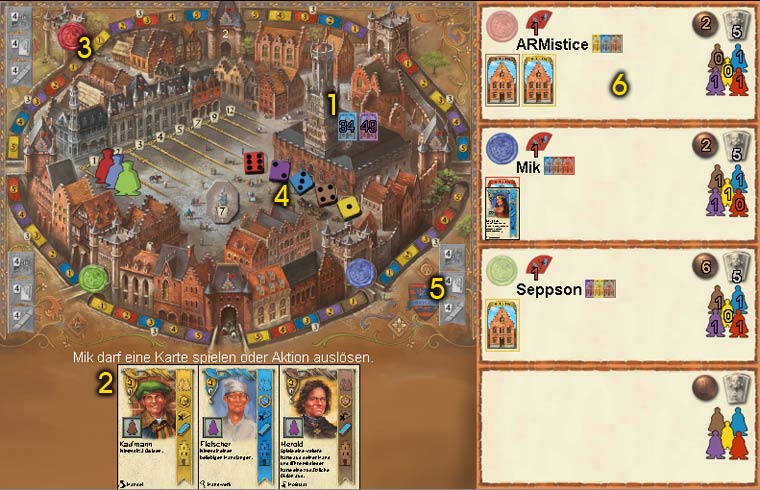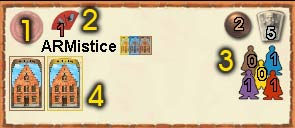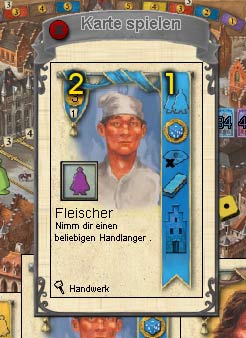Brügge
Game information
2 - 4 players slip at Bruges into the roles of merchants who maintain their relations with the powerful of the city. They compete for influence, power and status.
With the help of their handcards, players try to build houses and channels. Especially with the use of handcards as people you can gain special skills and points.
This rule mainly provides the operation for the online game. In addition, the original instructions can be used as complete rules on the publishing page. can be downloaded. YouTube also offers some video reviews for quick entry.
Field

- Postcard stack
- Own handcards
- Starter of the blue player
- Current cubes
- Majority marker of the red player
- Player's allowance
Above your own handcards, which action must be performed by which player at the moment.

On the right, the players' gamblers are visible. It is possible to recognize in the right-hand area (3) the own guilders, the already gained points of victory and the number of handlangers. By means of the seal (1) you can see which player is on the train and by clicking you can switch to the detailed map view of the respective player. In the left area above the name (2) you can see the threat markers of the respective player. Below (4) is the "outlay" of the player with its houses and people living in it.
Before the start of the game
In the game there are 165 playing cards in 5 different colors, these are also recognizable on the back for all. At the beginning, two hidden stacks are formed from which the players draw their hand cards.
Each player receives 5 guilders and 5 win points as start capital, and he receives a handlanger (5 different colors) per color.
Game sequence
Bruges run over several rounds in which each player comes 4 times to the row and performs a train each. At the beginning of a round the 5 cubes are thrown new. For each throw of a five or six players receive a threat marker of the corresponding color. If players then have 3 markers of a color, there will be damages that may result in loss of money, points of victory, buildings, people or handlangers. After that, each player can step up in the platforms. The costs are the sum of all cubes with numerical value 1 or 2.
In each train, each player must use one of his handcards, and CAN use before or after that actions of his already outlying persons. The game ends at the end of the round, where one of the two card stacks becomes empty. This will then be filled up so that you can draw further from 2 stacks.
After the end of the four trains, the majority in the areas of ascent, channel and persons are checked. If a player has the sole measurability, he will receive the corresponding marker he will retain until the end of the game. Regardless of whether he loses the majority.
Playing cards

In general, there are 6 different ways to play a card. If you are on the train, you choose the card to play. After that, you choose the way of use by clicking on either the corresponding icon in the right column (1) or by clicking on the cost (2), you can play the person into a free house if this is possible.
In addition to their colour and the costs already mentioned for the game, a person has a score of 0-4 at the end of the game, shown under the cost and belongs to one of 11 groups. This will be displayed on the map below.
From top to bottom, the following actions are possible:
- Handlanger take (2 handlanger in the color of the map)
- Gulden earn (corresponding to the cube value of the same-colored cube)
- Remove threat (1 Remove threat of card color + get 1 victory point)
- Build channel (1 channel to build a channel field of map color. Only possible if one of the two currently possible channel locations carries the appropriate color and you can pay the costs shown on the channel field.)
- Create a house in the map color. Costs: 1 hand length of the card colour)
The following action is finally possible at the top left:
- Extend person (requires a free building in any color. Furthermore, the costs shown must be paid.)
Player details

In the detailed view of a player you can see the features of the played personal cards. Here it is possible to use the card's ability by clicking on the "Retrieval symbol" (1). If the background is green, the card can be used. If the background is reddish, the card cannot be used at the moment.
There are the following card types:
The infinity symbol means that the function of the card can be triggered without additional costs. The symbol is also clicked for this purpose. If they don't affect a certain game situation (e.g. whenever you build a house), you can only use it once per round.
The handlanger symbol means that to trigger the function, you have to leave a handlanger in this color. To do this, click on the Handlanger symbol.
A laurel ring means you get points at the end of the game.
The flash symbol means that the function is triggered exactly once the card is removed.
With the change between function and name/points (2) you can choose between the description of functionality and the name and the points of victory to play the card. By means of the selectors (3), you can limit the display to action cards from top to bottom, show all cards or only show the winning point cards to the end of the game.
Below (4), the numbers of persons played are shown in the eleven groups of persons. This is crucial for many cards.
Playing
When the last round was finished, the game ends. At the end of the game all scores are added:
- Points through the ascent bar (1-12 points, depending on the level reached)
- Points through the canal construction/study (Je 3 points per page for 3 channels and up to 7 points per statue for a completely finished page)
- Points for buildings (1 point per house)
- Points for persons (0-4 points, depending on value)
- Points through victory score cards (according to the map of the people with laurel wreath)
- Points for the majority markers (each 4 points for ascent, channel and majority of persons)
The player with most win points wins. At the same time, the number of guilders decides. If there is equal status here, there are several winners.

